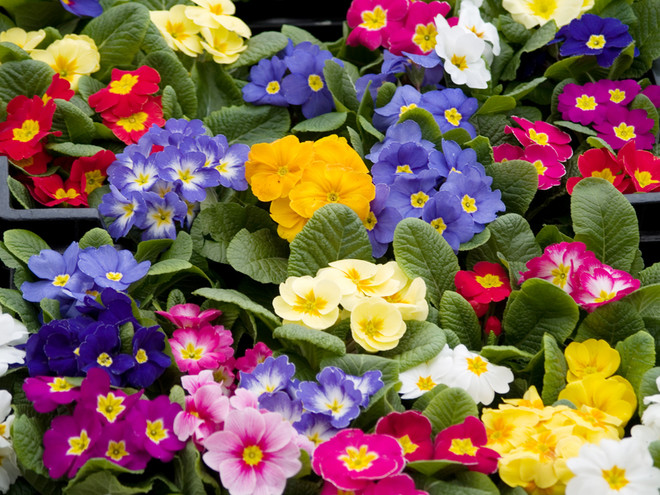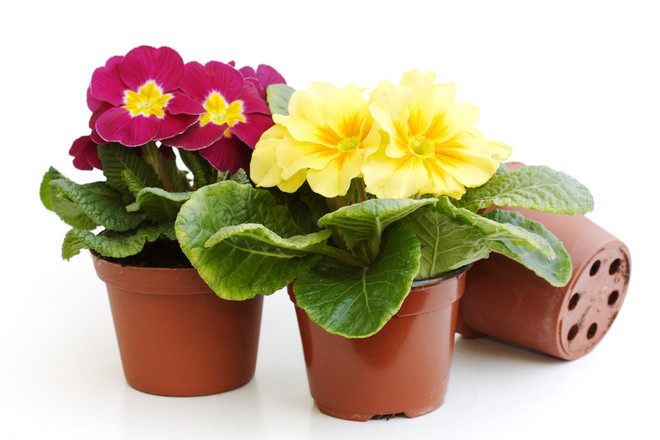Where they put
 Primrose planting and carePrimroses are low plants(10 to 50 cm), so they are used for borders, or planted as separate bright spots in the garden - under trees or among other later flowers. They prefer to grow in semi-shaded places on moderately moist soils.
Primrose planting and carePrimroses are low plants(10 to 50 cm), so they are used for borders, or planted as separate bright spots in the garden - under trees or among other later flowers. They prefer to grow in semi-shaded places on moderately moist soils.
Soil requirements
All primroses came to us from the Alpine beltmountains, so their habitat requirements are appropriate. They need calcium (ash or lime should be systematically added, or even better - dolomite flour). In addition, they do not like too rich soil (where, in the mountains, is humus-rich soil!). Therefore, when planting, rotted compost should be added to the ground in half with sand and ash. They will not grow on clays, as well as on peat bogs.
What to feed
Watering is especially important for primroses in the initial stages.the growth period in spring and until the end of flowering. Moderate feeding is required. If primroses are fed too abundantly, then, like all flowers, they will "grow fat", that is, produce a large mass of greenery and very few flowers. In the spring before flowering, calcium nitrate is best suited (incomplete tablespoon per 10 liters of water), since it contains calcium, which primroses love, and nitrogen, which is required for leaf growth. After flowering, to lay flower buds for next year, you should feed with phosphorus and potassium (without chlorine) - half a tablespoon of each (or a tablespoon of ready-made phosphorus-potassium fertilizer) per 10 liters of water. Primroses respond well to the introduction of any flower fertilizer, preferably not containing nitrogen. Both fertilizers are used per 10 m2 of plantings. In the fall, you need to add a little fresh compost under the primroses, literally a handful per bush.
How to seat
Primroses are biennials, not perennials, so they should be replanted every autumn (or at least every other year). The best time to replant is August.
- Dividing the bush.The easiest way to propagate is by young rosettes, carefully separating them together with the roots. You can plant young plants right here, not far from the mother plant. But you can't delay with transplanting, otherwise the rosettes will not have time to root properly and will die at the first frost.
- Seeds.Since the seeds are very small, they should be sown superficially or sown on snow in late February - early March. There is a small nuance here. After sowing, the bowls with seedlings should be placed in the refrigerator for several days and only then placed in a warm room, but not in direct sunlight. After the shoots appear, place the bowls in a bag, blow air into it several times, tie it and put it in the light. Water from a syringe through a needle stuck into the soil. When the seedlings grow up, they should be carefully pricked out into separate boxes or jars and grown to a bush with 5-6 true leaves, and then, after frosts, transplanted, first for further growth and only in August - to a permanent place. Primroses grow quite quickly, so provide them with space for this (20 by 20 cm). Primroses do not have pests or special diseases, so the plants do not require special care or maintenance.
Sometimes primroses try to bloom again - warm.in the fall. This should not be allowed. It is necessary to pluck the buds as soon as they appear, otherwise the plants may weaken and miss the spring flowering next year.
Timing of flowering
End of April - beginning of May Primroseвесенний зацветает самым первым. Из розетки морщинистых прикорневых листьев поднимается голый цветонос высотой 10-30 см с рыхлым зонтичным соцветием наверху. В природе цветки у этого растения желтые, диаметром 1,5 см. Но существует множество гибридных садовых форм, в том числе и махровых, самой разнообразной окраски.Первоцвет обыкновенный цветет примерно в это же время цветет . Это бесстебельная примула. Цветки у нее сидят по одному на концах коротеньких, неразвитых цветоносов. Но их обычно много, поэтому они образуют красочную подушку, высотой 10-12 см. Цветки довольно крупные (2-3 см в диаметре) разнообразной окраски, чаще желтые всяких оттенков, малиновые с желтым глазком. Наиболее популярны сорта Виргиния с белыми цветками и Церулея — с синими. Так же рано цветет и примула высокая, на цветоносах которой (высотой 20 см) располагаются сразу несколько цветков. При скрещивании этого вида с примулами обыкновенной и бесстебельчатой получено много красивых гибридов, среди которых наибольшей популярностью пользуются белая Альба, золотистая Ауреа, малиновая Гартенпримель, бархатно-коричневая Гольдранд и другие. От примулы высокой произошла и примула многоцветковая с крупными соцветиями из 15-20 цветков на высоком цветоносе (40 см).Середина маяВ середине мая расцветает одна из самых красивых примул — примула мелкозубчатая. Свое название она получила за зазубренные края листьев, из розетки которых на высоких цветоносах (30-40 см в начале цветения и 50-60 см после окончания) располагаются шаровидные соцветия, состоящие из множества мелких цветков самого разнообразного окраса (от белого и розового – до лилового разной интенсивности и малинового).Одновременно цветет и низенькая, всего 10-12 см высотой, примула Юлии с малиновыми цветками. Есть гибрид и с белыми цветками, но наиболее красива смесь с романтическим названием Ромео и Джульетта с розовыми и голубыми цветками. В момент цветения примула Юлии образует сплошные коврики и очень хороша на альпийской горке. Кстати, это наиболее морозостойкая и неприхотливая из примул. Чуть позже зацветает примула ушковая с необычными плотными, гладкими листьями сизо-зеленого цвета, которые как бы немного завернуты, наподобие ушей какого-то неведомого зверька. Цветки диаметром 3-4 см собраны в зонтики по 5-15 штук. Они имеют необычную круглую с фестончиками форму и двухцветную бледноватую окраску фиолетово-сиреневого тона разных оттенков. Есть очень интересный гибрид этой примулы — примула опушенная.Конец маяВ самом конце мая зацветает японская примула Зибольда — невысокое растение со светло-зелеными листьями и нежно-розовыми с белой звездочкой в середине цветками, собранными в рыхлый зонтик. У нее есть одна особенность. После отцветания надземная часть ее пропадает, а потому, чтобы случайно не повредить или не затоптать спящее растение, следует помечать места ее посадки.Июнь – июльВ июне-июле цветут редкие в наших садах примулы группы Канделябровые, они родом из Японии. На высоких цветоносах (50 см) в несколько ярусов располагаются соцветия ярких пурпурных цветков. Начинают цвести с нижних ярусов. Существуют садовые формы с цветками белого, розового, сиреневого, вишневого цветов. Среди канделябровых примул есть примула Биса с фиолетово- сиреневыми цветками и примула Булля с кремово-желтыми и оранжевыми цветками, а также их гибрид примула буллезиана с очень красивыми коралловыми цветками.Июль – августПоследней в сезоне зацветает примула Флоринда, родиной которой является Тибет. Эта редкая у нас примула цветет с конца июля до середины августа. Из розетки красивых крупных листьев вырастает длинный цветонос (70-80 см), увенчанный очень яркой оранжевой кистью из колокольчатых ароматных цветков. Это растение прекрасно смотрится около водоема.









